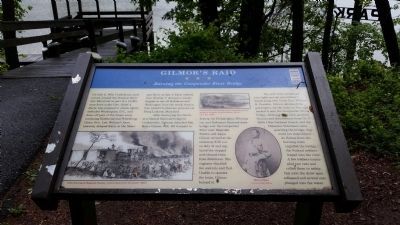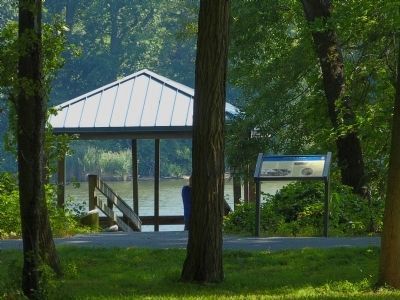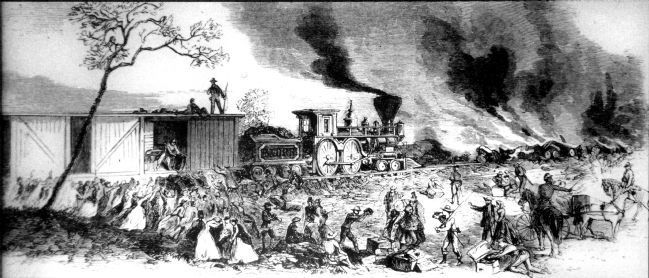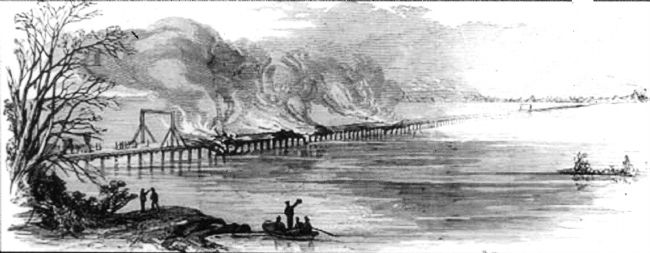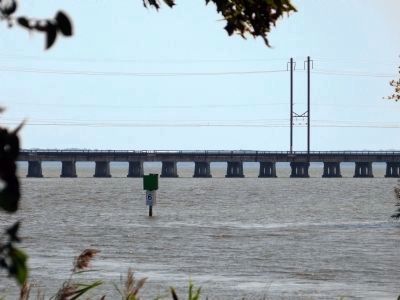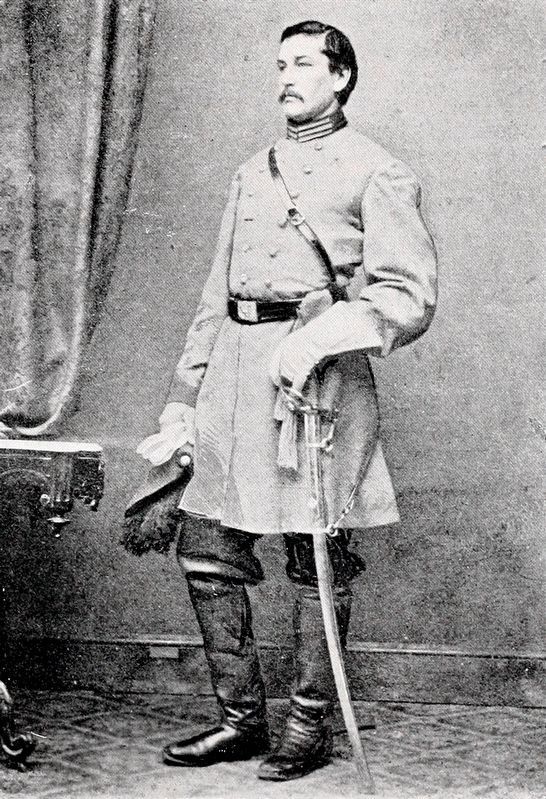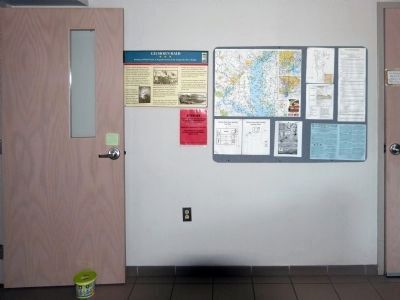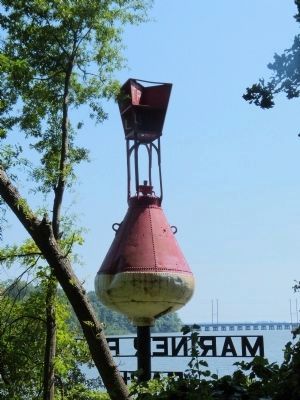Joppatowne in Harford County, Maryland — The American Northeast (Mid-Atlantic)
Gilmor's Raid
Burning the Gunpowder River Bridge
Inscription.
On July 6, 1864, Confederate cavalrymen crossed the Potomac River into Maryland as part of a 12,000 man force under Gen. Jubal A. Early, who planned to attack lightly defended Washington, D.C., and draw off part of the Union army menacing Richmond and Petersburg. Union Gen. Lew Wallace's force, however, delayed Early at the Monocacy River on July 9. Early ordered Gen. Bradley T. Johnson's cavalry brigade to cut off Baltimore and Washington from the north, then to free 14,000 Confederate prisoners at Point Lookout, Maryland.
After destroying the Northern Central Railroad bridge in Cockeysville, Johnson detached Maj. Harry Gilmor with 135 troopers to destroy the Philadelphia, Wilmington and Baltimore Railroad drawbridge over the Gunpowder River near Magnolia Station and Joppa. Gilmor arrived at the station at 8:30 A.M. on July 11 and captured the stopped northbound train from Baltimore. The engineer disabled the controls and fled. Unable to operate the train, Gilmor burned it.
The next train arrived an hour later and fell into Gilmor's hands along with Union Gen. William B. Franklin. Gilmor detrained the passengers, set the train on fire and backed it onto the Gunpowder River bridge. Although the Union gunboat Juanita and detachments from Co. F, 159th Ohio National Guard, and the Delaware Volunteers were guarding the bridge, they could not stop Gilmor. As the flames from the burning train engulfed the bridge, the Federal soldiers leaped into the river. A few soldiers uncoupled two cars and rolled them to safety, but soon the draw span collapsed and several cars plunged into the water.
(captions)
(lower left) Train Burning at Magnolia Station, Leslie's Illustrated Newspaper (1864)
(upper right) "Destruction of the Bridge Over Gunpowder Creek," Benson J. Lossing, Pictorial History of the Civil War (1866)
(lower right) Harry Gilmor Courtesy Dave Marks
Erected by Maryland Civil War Trails.
Topics and series. This historical marker is listed in this topic list: War, US Civil. In addition, it is included in the Maryland Civil War Trails series list. A significant historical month for this entry is July 1864.
Location. 39° 23.771′ N, 76° 20.906′ W. Marker is in Joppatowne, Maryland, in Harford County. Marker can be reached from Kearney Drive south of Latimer Road. Marker is located in the back of Mariner Point Park. Touch for map. Marker is at or near this postal address: 100 Kearney Drive, Joppa MD 21085, United States of America. Touch for directions.
Other nearby markers. At least 8 other markers are within 4 miles of this marker, measured as the crow flies. Rumsey Mansion (approx. one mile away); Joppa Town (approx. 1.1 miles away); Gunpowder River (approx. 2.2 miles away); “Long Calm” (approx. 3.4 miles away); Union of Brother and Sisters of Ford’s Asbury Lodge No. 1 (approx. 3.4 miles away); Reefs of the Chesapeake … Past … Present … Future (approx. 3˝ miles away); An All-American Bird (approx. 3˝ miles away); Explore Your Chesapeake (approx. 3˝ miles away). Touch for a list and map of all markers in Joppatowne.
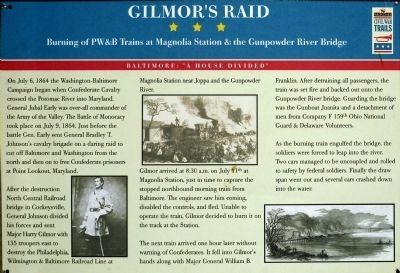
Photographed By Allen C. Browne, August 27, 2014
7. Gilmor's Raid
Burning of PW&B Trains at Magnolia Station & the Gunpowder River Bridge
Burning of PW&B Trains at Magnolia Station & the Gunpowder River Bridge
On July 6, 1864 the Washington Baltimore Campaign began when Confederate Cavalry crossed the Potomac River into Maryland. General Early was over-all commander of the Army of the Valley. The Battle of Monocacy took place on July 9, 1864. Just before the battle Gen. Early sent Bradley T. Johnson's cavalry brigade on a daring raid to cut of Baltimore and Washington from the north and then free prisoners at Point Lookout, Maryland.
After the Destruction (of the) North Central Railroad bridge in Cockysville, General Johnson divided his forces and sent Major Harry Gilmor with 135 troopers east to destroy the Philadelphia, Wilmington & Baltimore Railroad Line at Magnolia Station near Joppa and the Gunpowder River.
Gilmor arrived at 8:30 a.m. on July 11th at Magnolia Station, just in time to capture the stopped northbound morning train from Baltimore. The engineer saw him coming, disabled the controls, and fled. Unable to operate the train, Gilmor decided to burn it on the track at the Station.
The next train arrived one hour later without warning of Confederates. It fell into Gilmor's hands along with Major General William B. Franklin. After detraining all passengers, the train was set (on) fire and backed out onto the Gunpowder River Bridge. Guarding the bridge was the Gunboat Juniata and a detachment of men from Company F 159th Ohio National Guard & Delaware Volunteers.
As the burning train engulfed the bridge, the soldiers were forced to leap into the river. Two cars managed to be uncoupled and rolled to safety by federal soldiers. Finally the draw span went out ands several cars crashed down into the water.
Civil War Trails Marker inside the Mariner's Point Park Visitors' Center.
Credits. This page was last revised on July 10, 2021. It was originally submitted on May 16, 2014. This page has been viewed 1,556 times since then and 98 times this year. Last updated on July 4, 2021. Photos: 1. submitted on May 16, 2014, by Randy Meldron of Joppa, Maryland. 2, 3, 4, 5. submitted on August 28, 2014, by Allen C. Browne of Silver Spring, Maryland. 6. submitted on June 8, 2021, by Allen C. Browne of Silver Spring, Maryland. 7, 8, 9. submitted on August 28, 2014, by Allen C. Browne of Silver Spring, Maryland. • Bill Pfingsten was the editor who published this page.
